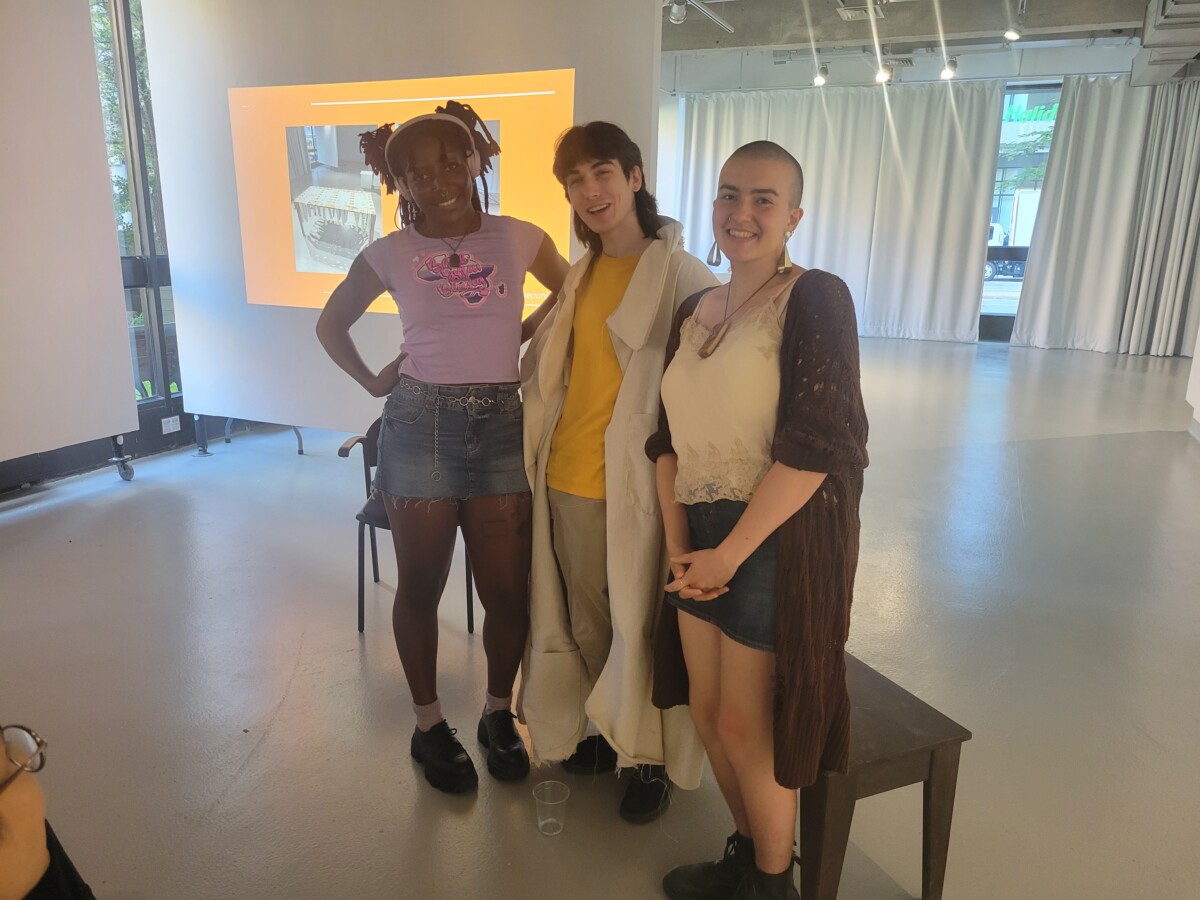Concordia’s undergraduate gallery invited the public to listen to three artists-in-residence speak on their work in progress.
Concordia’s VAV Gallery in Sir George Williams campus’ VA building recently hosted an intimate conversation with three artists who participated in their summer residency program as they prepare for their upcoming vernissage. Inka Kennepohl, Spencer Magnan and Emem Etti shared how their distinct studio practices all converge on themes of identity, introspection and material exploration.
All three artists emphasize the value of a process that demands focus and concentration, one that generates a contemplative state of mind as they are at work. This method opens up an introspective space for the artist to dwell in as they engage in a very physical, repetitive process. Every knot and stitch is infused with the care and patience of the maker’s hand—they inevitably speak to a deep connection between the material and the body.
Nigerian-Canadian artist Emem Etti’s practice blends the disciplines of film and fibres to create dynamic installations of video projection that animate their handmade rugs. Their work at VAV was largely an effort to orient their energy inward, to reach an ambitious state of mindfulness achieved through the consistent, rhythmic motions of handcrafting.
During the panel discussion, Etti noted the deliberate choice to use a punch-needle to craft their rugs rather than the more efficient needle gun, for using the gun was a “violent” experience—the tool is difficult to control. While it works faster than going stitch-by-stitch, it tends to be a chaotic creative process rather than the steady, intentional method the artist prefers. Etti remarks: “I think there is something really beautiful about the meticulous.” This decision speaks to Etti’s concern with the relationship between the artist and their materials. There is an intimacy there, as the artwork is an extension of the artist. The care and time the artist spends engaging with the material is tantamount to tenderly caring for their own body. The final product, the rug, is a symbol of connection, of being radically present with the self.
In a similar fashion, Spencer Magnan draws from personal experience as a queer artist to inform his theatrical, oversized wearable pieces. During his time at VAV, Magnanhand-sewed a giant suit jacket made entirely of unstretched canvas. The work serves as a commentary on the inherently masculine-coded garment and playfully reinterprets it as a dramatic costume, hinting at the performative nature of gender expression. Magnan chose this material to add another layer of gender identity to the piece. “I feel like in 2023, it’s still a very masculine thing to make a painting,” Magnan says, pointing to the persistently male-dominated discipline that continues to root itself in rigidly exclusionary and eurocentric traditions.
The artist consciously left the canvas unpainted and allowed the qualities of the raw material—the rough texture, the loose-hanging threads, the sandy colour, and the visible hand-stitching—to constitute the character of the jacket. This decision undermines the expectations of what a proper, masculine suit jacket is expected to be—polished, tailored, and luxurious. It reinterprets the garment through a queer sensibility that refuses to conform to an established, heteronormative standard and rather celebrates imperfection, individuality, and drama.
Meanwhile, Inka Kennepohl engages with textiles differently. Moving away from the commercial practice of creating luxury commodities out of textiles, they use the techniques as a means of object repair. Their work during their residency at VAV combined macramé, a knotting technique, and furniture design to assemble pieces that exist somewhere between the functional and the conceptual. Kennepohl spoke of the ways sustainability informs their sculptural practice and emphasized the urgency of rebuilding and repurposing materials through acquired skill rather than discarding them and perpetuating a cycle of consumption and waste.
Their work sparked conversations regarding the relationship between labour and art, and raised important questions concerning the boundaries an artist should draw between the integrity of their vision and the very real need to maintain a marketable production capacity in order to make a living. The discussion addressed pressing questions that seem to permeate this emerging generation of young artists. How can they honour the slow and steady process of handcrafting a work of art in such a fast-paced consumer culture? How should they tread the fine line between supporting ourselves and refusing to concede to commercialization?
The cumulative bodies of work produced by Etti, Magnan and Kennepohl during their summer residency will be featured in the VAV Gallery space this fall, and the vernissage will be held Monday, September 11, 2023.
